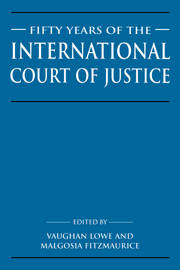Book contents
- Frontmatter
- Contents
- List of contributors
- Preface
- List of abbreviations
- Sir Robert Yewdall Jennings, by Vaughan Lowe
- List of publications of Sir Robert Jennings
- Table of cases
- Part I The International Court of Justice
- Part II The sources and evidences of international law
- Part III Substance of international law
- Part IV Procedural aspects of the work of the International Court of Justice
- 21 Procedural law and the International Court of Justice
- 22 The President of the International Court of Justice
- 23 Nationality of claims: some relevant concepts
- 24 The plea of domestic jurisdiction before the International Court of Justice: substance or procedure?
- 25 ‘Partial’ judgments and the inherent jurisdiction of the International Court of Justice
- 26 Intervention before the International Court of Justice
- 27 The use of Chambers of the International Court of Justice
- 28 The use of experts by the International Court of Justice
- 29 Provisional measures
- 30 Remedies in the International Court of Justice
- 31 A comment on the current health of Advisory Opinions
- Part V The International Court of Justice and the United Nations
- Index
29 - Provisional measures
Published online by Cambridge University Press: 02 November 2009
- Frontmatter
- Contents
- List of contributors
- Preface
- List of abbreviations
- Sir Robert Yewdall Jennings, by Vaughan Lowe
- List of publications of Sir Robert Jennings
- Table of cases
- Part I The International Court of Justice
- Part II The sources and evidences of international law
- Part III Substance of international law
- Part IV Procedural aspects of the work of the International Court of Justice
- 21 Procedural law and the International Court of Justice
- 22 The President of the International Court of Justice
- 23 Nationality of claims: some relevant concepts
- 24 The plea of domestic jurisdiction before the International Court of Justice: substance or procedure?
- 25 ‘Partial’ judgments and the inherent jurisdiction of the International Court of Justice
- 26 Intervention before the International Court of Justice
- 27 The use of Chambers of the International Court of Justice
- 28 The use of experts by the International Court of Justice
- 29 Provisional measures
- 30 Remedies in the International Court of Justice
- 31 A comment on the current health of Advisory Opinions
- Part V The International Court of Justice and the United Nations
- Index
Summary
Provisional measures – so called in the Statute and the Rules of Court, but placed under the heading of ‘interim protection’ in the latter (part III, Section D, sub-section 1) – are called in French ‘mesures conservatoires’, which more properly reflects the nature of this institution. The indication of provisional measures – which is deemed to be an almost essential instrument in the panoply of any judicial process – is intended to preserve, pending the final decision, the respective rights of the parties before the Court. The provision constituting article 41 of the PCIJ's 1920 Statute, which relates to this institution, was inherited by the Statute of the ICJ which provides in article 41 that ‘the Court shall have the power to indicate, if it considers that circumstances so require, any provisional measures which ought to be taken to preserve the respective rights of either party’. The practice of both the predecessor and present Courts, in relation to this proceeding, is indicated in table 1.
PRACTICE
During the period of the PCIJ, there were six cases in which the Court received requests for the indication of provisional measures. In only two of them were provisional measures indicated by the Court. In the case concerning Denunciation by China of the 1865 Treaty (No. 1 in table 1), the Court's Order granting the request of an applicant, Belgium, was, however, withdrawn some weeks later.
- Type
- Chapter
- Information
- Fifty Years of the International Court of JusticeEssays in Honour of Sir Robert Jennings, pp. 541 - 556Publisher: Cambridge University PressPrint publication year: 1996
- 8
- Cited by

